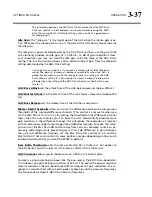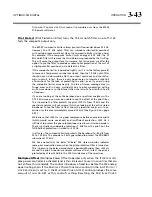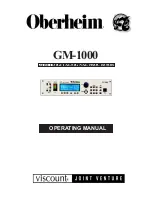
3-42
OPERATION
ORBAN MODEL 8500S
When operating as a hard clipper, the composite limiter will produce
maximum brightness in the frequency range from 5 to 15 kHz because,
unlike the 8500S’s left/right audio-domain peak limiters, it can produce
square waves in this frequency range. The downside compared to Half-
Cosine mode is that it can noticeably compromise stereo imaging.
When operating in Half-Cosine mode, the composite limiter produces
somewhat less brightness but does not compromise stereo imaging.
In either mode, the baseband output is overshoot compensated and
bandlimited to 53 kHz (
), unlike conventional composite clip-
pers.
Composite Limit Drive
sets the drive level, in dB, into the 8500S’s composite lim-
iter.
This control has no effect on the 8500S’s left and right analog or digital outputs.
The
COMP
DRV
control is set to “0 dB” for most factory presets. At this
setting, it removes a few tenths of a dB of residual overshoot from the
audio processing without affecting audio quality. We prefer to use the
audio-domain overshoot compensation to do most of the work because
it operates at a 256 kHz sample rate and is fully anti-aliased, whereas the
composite limiter will inevitably introduce aliasing around 38 kHz upon
demodulation in the receiver. This is because it introduces spectrum in
the stereo subchannel area when it clips material in the 0 to 15 kHz area.
The receiver will “see” this as stereo material, and will demodulate it as if
it were part of the stereo subchannel. Accordingly, harmonics of L+R ma-
terial will be frequency-shifted upon demodulation, and will no longer
bear a harmonic relationship to the material that produced them.
Mathematically, these harmonics will be located at the same frequencies
as harmonics caused by clipping in a simple digital-domain clipper (with
no anti-aliasing) operating at 38 kHz sample rate.
If you want to use the composite limiter more heavily, one option is to
trade off composite limiting against left/right domain overshoot com-
pensation. To do this, reduce the
O
VERSHOOT
C
OMPENSATOR
D
RIVE
control
and increase the
COMP
DRV
control setting proportionately. (The
SRS
57.088 kHz
-72.881
dBVpk
0 Hz
FFT 1 Log Mag BMH
PkhAvg
20000
51.2 kHz
102.4 kHz
-100
dBVpk
0
dBVpk
10
dB/div
Figure 3-1: 0-100 kHz Baseband Spectrum
(Loud-Hot preset)
SRS
19 kHz
-20.643
dBVpk
15.8 kHz
FFT 1 Log Mag BMH
PkhAvg
869
19 kHz
22.2 kHz
-100
dBVpk
0
dBVpk
10
dB/div
Figure 3-2: 19 kHz Pilot Notch Filter
Spectrum (Loud-Hot preset; detail)
Summary of Contents for OPTIMOD-FM 8500S
Page 1: ...Operating Manual OPTIMOD FM 8500S Digital Audio Processor Version 1 0 Software...
Page 7: ...Operating Manual OPTIMOD FM 8500S Digital Audio Processor Version 1 0 Software...
Page 26: ......
Page 56: ......
Page 164: ......
Page 308: ......
Page 310: ...6 28 TECHNICAL DATA ORBAN MODEL 8500S CONTROL BOARD PARTS LOCATOR...















































